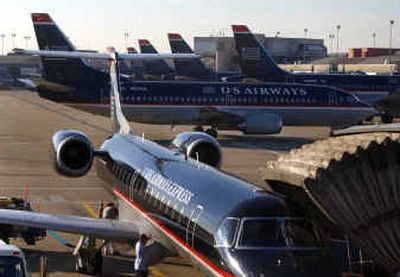Airlines face day of reckoning

WASHINGTON – Several long-suffering airlines appear to have reached a breaking point, with fuel prices unrelentingly high, cash reserves dwindling and customers addicted to cheap fares. US Airways may file for bankruptcy court protection a second time and could be forced to liquidate, Delta is on the precipice of bankruptcy and United is battling an employee revolt as it aims to scrap its pension plans.
The frantic restructuring under way at these carriers and others means more anguish for workers and shareholders, although fliers in most markets should continue to see an abundance of low fares. While not every carrier is guaranteed to survive, analysts say the imminent upheaval could augur a brighter long-term future for the industry.
“This is the beginning of the recognition that surgery is necessary for the legacy carriers,” said Michael E. Levine, a former airline executive who teaches law at Yale University. “And while it’s painful, and not all of the surgery will be successful, it’s the only way they’re going to get healthy.”
What ails carriers such as Delta Air Lines Inc. and US Airways Group Inc. more than anything else is the disproportionately high cost of their operations.
This makes it nearly impossible for them to compete with efficient, well-financed and fast-growing carriers such as Southwest Airlines Co. and JetBlue Airways Corp., whose cheap fares have become the standard by which budget-conscious fliers comparison shop. In fact, their larger competitors – whose costs per available seat mile in some cases are more than 30 percent higher than those of Southwest – have slashed ticket prices to unprofitable levels on many routes just to keep their customer bases from shrinking further.
“Pricing power has moved from the airlines to the consumer,” said Phil Roberts, managing partner of the transportation consultancy Unisys R2A in Oakland, Calif. “And so what it comes down to, in the end, is the large carriers needing to create a cost base where they can be profitable at these price levels.”
With cash reserves shrinking rapidly and earlier efforts to slash expenses proving inadequate, some of the nation’s largest airlines are now moving ahead with dramatic transformation plans.
•Delta sketched plans this week to eliminate up to 7,000 jobs, cut employee wages and shed its Dallas hub as part of a $5 billion cost-saving program. The Atlanta-based airline has warned that it could be forced into bankruptcy soon if it cannot stem a recent surge in early retirements among older pilots, who are taking big lump-sum pension payments for fear that their retirement accounts could be wiped out as part of the airline’s makeover.
•US Airways made a last-ditch offer to its divided pilots union Friday for a new labor contract. It says it needs $800 million in labor concessions in order to avoid its second Chapter 11 filing in less than two years, and possibly a liquidation. The day of reckoning for the Arlington, Va., carrier could come as early as this weekend. Among other strategic changes, US Airways plans to simplify its fare structure and tweak its hub-and-spoke route network to more closely emulate the point-to-point networks that have been successful for low-fare carriers.
•United parent UAL Corp., which has been operating under Chapter 11 since December 2002, is putting together its third turnaround proposal to a bankruptcy judge. As part of that process, United has threatened to terminate its pension plans in order to attract additional financing. United CEO Glenn Tilton recently said in a recorded message to employees that the airline could save $625 million a year through new call center, maintenance, airport station and commuter-carrier agreements, though he did not detail how the savings would be achieved.
•Alaska Air Group Inc. on Thursday increased the number of employees it plans to lay off by 750, bringing the total to about 900, as part of a broader plan to save $35 million a year.
Duane Woerth, president of the Air Line Pilots Association, said he is optimistic that the latest moves will be more effective than the post-Sept. 11, 2001, strategy of laying off tens of thousands of workers and getting the remainder to accept lower wages and benefits.
While job and pay cuts remain in the mix this time around, the troubled airlines also appear intent on reshaping their operations from head to toe, he said.
This means retrenching from certain markets – Delta from Dallas, US Airways from Pittsburgh – in order to sharpen their focus in fewer, select cities where they stand the best chance of growing. And it means utilizing aircraft and employees more efficiently, so that they have less idle time in which expenses are incurred but no revenue comes in.
A key factor exacerbating the major carriers’ problems in recent months has been the stubbornly high cost of oil, which makes jet fuel more expensive too. Because fliers are so price sensitive, carriers have been largely unsuccessful at raising fares to pass along the higher fuel costs, magnifying their losses.
Merrill Lynch estimates that the nine largest U.S. carriers will lose some $700 million during the July-September quarter, which is traditionally the industry’s strongest due to summer travel. Had fuel prices held steady at last year’s levels, those same carriers would have turned a profit of about $500 million, the investment bank said in a report.
The flurry of restructuring now under way will hit airline employees the hardest, analysts said, though there are also financial risks ahead for travelers, aircraft manufacturers, small companies that provide airport-support services such as catering and cleaning – and even rival carriers.
Low-fare leaders Southwest and JetBlue have little to worry about near-term, experts said.